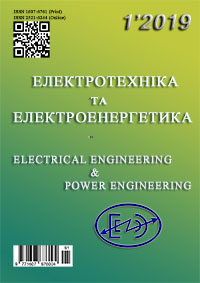OPTIMIZATION OF TIMES OF MAGNETIZATION AND DEMAGNECTION OF STOPPED FREQUENCY-REGULATED SYNCHRONOUS MOTORS
DOI:
https://doi.org/10.15588/1607-6761-2019-1-1Keywords:
, synchronous motor, frequency regulation, electric power loss, optimizationAbstract
Purpose. Obtaining analytical calculated dependencies for finding the optimal time of magnetization and demagnetization of stopped frequency-regulated synchronous motors and the corresponding minimum energy loss in these motors for the regimes of magnetization and demagnetization.
Methodology. Variational calculus and the theory of similarity, operator method and computer simulation.
Findings. When varying the duration of the magnetization and demagnetization times, electrical energy losses were researched during magnetization and demagnetization of stopped synchronous motors for various types of them (with excitation winding in the presence or absence of damping windings; with permanent magnets; synchronous-jet motor) and with different trajectories (optimal, linear and parabolic) changes in the flux linkage and currents of these motors. The optimal type of paths of change in the flux linkage (or current) for each of the motor types researched is determined, corresponding to the minimization of energy loss in these machines under magnetization and demagnetization regimes. The minimum energy losses and the corresponding optimal magnetization and demagnetization times for the considered types of synchronous motors are calculated.
Originality. For the investigated types of synchronous motors analytical dependences are proposed for calculating the optimal magnetization and demagnetization times, which ensure minimal energy losses in these motors under magnetization and demagnetization regimes. Analytical dependences are obtained for calculating the minimum energy losses in the indicated motors under these conditions.
Practical value. Through the optimization of the magnetization times and demagnetization, the considered types of synchronous motors are reduced by a factor of 1.2 – 1.4 times or more for the energy losses of their regimes magnetization and demagnetization.
References
[1] Sinyugin, V.YU., Magruk, V.I., Rodionov, V.G. (2018). Gidroakkumuliruyushchiye elektro-stantsii v sovremennoy energetike [Pumped storage power plants in modern energy]. ENAS, 352. (in Russia).
[2] Beschastnov, G.A., Karpov, A.M., Nemeni, T.M., Semenova, G.S. (1980). Raschet protsessa puska obratimogo agregata GAES ot staticheskogo preobrazovatelya chastoty [Calculation of the start-up process of a reversible unit of a PSPP from a static frequency converter]. Elektrichestvo, 3, 15 – 19.
[3] Veynger, A.M. (1985). Reguliruyemyy sinkhronnyy elektroprivod [Adjustable synchronous electric drive]. Energoatomizdat, 224. (in Russia).
[4] Kopylov, I.P., Klokov, B.K., Morozkin, V.P., Tokarev, B.F. (2011). Proyektirovaniye elektricheskikh mashin [Designing electric engines]. Yurayt, 767. (in Russia).
[5] Krishnan, R. (2010). Permanent magnet synchronous and brushless DC motor drives. CRC Press, 564.
[6] Synchronous Reluctance Motor RSB Su Prem E.B (2014). Type Series Booklet.
[7] Zakharov, V.N. (2018) Sinkhronno-reaktivnyye dvigateli: legkiye, nadezhnyye, effektivnyye i nedorogiye [Synchronous jet engines: light, reliable, efficient and inexpensive]. Promyshlennaya elek-trotekhnika i privody, 1 – 5. (in Russia).
[8] Polyakov, V.N., Shreyner, R.T. (2006). Ekstremal'noye upravleniye elektricheskimi dvigatelyami [Extreme control of electric motors]. UGTU–UPI, 420. (in Russia).
[9] Bose, B.K. (2002) Modern power electronics and AC drives. Prentice Hall RTR, 711.
[10] Volkov, V.A. (2018). Analiticheskiy raschet i optimizatsiya osnovnykh elektromagnitnykh poter' energii chastotno-reguliruyemogo sinkhronnogo dvigatelya s postoyannymi magnitami v pusko-tormoznykh re-zhimakh [Analytical calculation and optimization of the main electromagnetic energy losses of a frequency-regulated synchronous engine with permanent magnets in the start-braking regime]. Yelektromekhaníchní í energozberígayuchí sistemi. 2 (42), 8 – 22. (in Ukraine).
[11] Volkov, V.A. (2018). Energosberegayushcheye upravleniye tyagovym chastotno-reguliruyemym sinkhronno-reaktivnym dvigatelem [Energy-saving control of a variable frequency-regulated synchronous engine]. Yelektromekhaníchní í energozberígayuchí sistemi. 3 (43), 8 – 23. (in Ukraine).
[12] Volkov, V. (2017). Optimization of times of running and braking of position frequency-regulated asynchronous electric drives.Electrical Engineering And Power Engineering, 1, 48-60. doi:http://dx.doi.org/10.15588/1607-6761-2017-1-7
[13] Pivnyak, G.G., Volkov, A.V. (2006). Sovremennyye chastotno-reguliruyemie asinkhronnyye elektroprivody s shirotno-impul'snoy modulyatsiyey [Modern frequency-controlled asynchronous electric drives with pulse-width modulation] NGU, 470. (in Ukraine).
[14] Venikov, V.A. (1976) Teoriya podobiya i modelirovaniya [The theory of similarity and modeling]. 479. (in Russia).
[15] Petrov, YU.P. (1977). Variatsionnyye metody teorii optimal'nogo upravleniya [Variational methods of the theory of optimal control]. 280. (in Russia).
[16] Korn, G., Korn, T. (1973). Saprovochnik po matematike (dlya nauchnih rabotnikov i ingenerov) [Mathematical handbook (for scientists and engineers)]. 832. (in Russia).
Downloads
Published
How to Cite
Issue
Section
License
Copyright (c) 2019 V.A. VOLKOV

This work is licensed under a Creative Commons Attribution 4.0 International License.
Creative Commons Licensing Notifications in the Copyright Notices
Authors who publish with this journal agree to the following terms:
Authors retain copyright and grant the journal right of first publication with the work simultaneously licensed under aCreative Commons Attribution License that allows others to share the work with an acknowledgement of the work's authorship and initial publication in this journal.
Authors are able to enter into separate, additional contractual arrangements for the non-exclusive distribution of the journal's published version of the work (e.g., post it to an institutional repository or publish it in a book), with an acknowledgement of its initial publication in this journal.
Authors are permitted and encouraged to post their work online (e.g., in institutional repositories or on their website) prior to and during the submission process, as it can lead to productive exchanges, as well as earlier and greater citation of published work.

